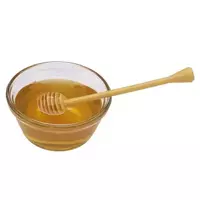Artificial honey

It is worth noting that the product, which is called artificial honey, has nothing to do with natural honey, which is well known to the inhabitants of our latitudes. However, artificial honey has some similarities with a natural natural product. Artificial honey is a product that is produced in the food industry of their sugar-containing raw materials.
In turn, sugar-containing raw materials are understood as cane or beet sugar. In addition, artificial honey is obtained from corn molasses, as well as from fruits such as melon, grapes or watermelon. It is also noteworthy that in the process of production, artificial honey is tinted with natural dyes.
As a rule, saffron, decoctions based on St. John's wort or black tea are used to make artificial honey. The lowest quality types of artificial honey are tinted with synthetic food dyes. In order to achieve the greatest similarity with a natural food product, a certain amount of ordinary bee honey is often mixed into artificial honey.
Food manufacturers claim that pulp or juice of melons, as well as some varieties of fruits, are best suited for the production of artificial honey. Artificial honey is a fairly profitable food product for manufacturers. The thing is that for the production of artificial honey they use fruits that have lost their commercial appearance and are only suitable for processing.
Although artificial honey is similar to a natural such product does not have a characteristic honey taste or aroma. Most often, artificial honey is obtained by hydrolysis of a special type of sugar beet. Citric acid is used in production of artificial honey. The beetroot juice is evaporated to the required consistency.
To obtain artificial honey from fruits, the initial raw materials are pressed and then also evaporated to a "honey" consistency. The chemical composition of artificial honey contains water, sucrose, as well as glucose and fructose. Natural enzymes, pollen, as well as dextrins are not present in artificial honey. Such a product as artificial honey has found wide use in confectionery.
In addition, artificial honey is especially popular with manufacturers of baked goods and bakery products. Artificial honey is considered a cheap replacement for a natural product. Often artificial honey serves as a substitute for sugar. We do not talk about the beneficial properties of artificial honey, since this product has nothing to do with natural bee honey.
However, the composition of artificial honey contains a certain amount of compounds useful for the human body, which were originally contained in the starting material that was used to produce the product.
artificial honey 292 kCal
Energy value of artificial honey (Ratio of proteins, fats, carbohydrates - ju):
Proteins: 0 g (~ 0 kCal)
Fats: 0 g (~ 0 kCal)
Carbohydrates: 77 g (~ 308 kCal)
Energy ratio (bj | y): 0% | 0% | 105%
 Español
Español Français
Français Português
Português Русский
Русский 简体中文
简体中文 繁體中文
繁體中文 日本語
日本語 한국어
한국어 العربية
العربية Türkçe
Türkçe Қазақ
Қазақ Deutsch
Deutsch Italiano
Italiano Українська
Українська
